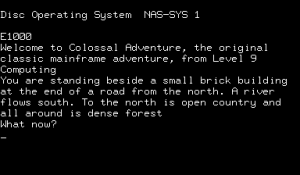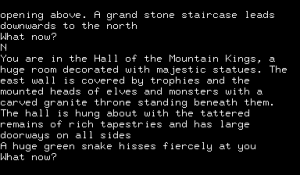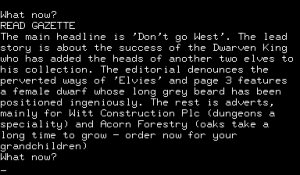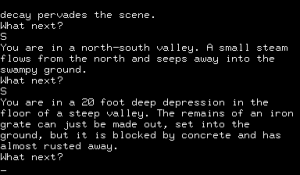Before the likes of the Sinclair ZX80 and ZX81 and the Acorn Atom which I discussed in a previous post on British computing, there were the solder-them-yourself kits which began to arrive in 1978. The most long-lived and successful of these were the products of a small company called Nascom. The obvious American counterpart to the Nascom was the original kit PC, the Altair. That said, the Nascom was actually a much more complete and capable machine once you got it put together (no easy feat). It came, for example, with a real keyboard in lieu of toggle switches, and with video output in lieu of blinking lights. Like the Altair, the Nascom was open and flexible and eminently hackable, a blank canvas just waiting to be painted upon. (How could it not be open when every would-be user had to literally build her machine for herself?) In the case of the Altair, those qualities led to the so-called S-100 bus standard that, in combination with the CP/M operating system, came to dominate business computing in the years prior to the arrival of the IBM PC. In case of the Nascom, they spawned the 80-Bus architecture that could eventually also run CP/M, thanks to the Nascom’s use of the Zilog Z-80 processor that was also found in most of the American CP/M machines. A hardcore of committed users would cling to their Nascoms and other 80-Bus machines well into the 1980s even in the face of slicker, friendlier mass-market machines that would soon be selling in the millions.
One of the Nascom buyers was a 25-year-old named Pete Austin. He had finished a psychology degree at Cambridge when, “looking for an excuse to stay there for an extra year” before facing the real world of work and responsibility, he signed up for a one-year course in computing. He discovered he was very, very good at it. After finishing the course, he began a career as a programmer, mostly coding applications in COBOL on big-iron machines for banks and other big institutions. He quickly found that he wasn’t as excited by the world of business computing as he had been by the more freewheeling blue-sky research at Cambridge. But while programming accounting packages and the like may not have been exciting, it did pay the bills nicely enough. At least he earned enough to buy a Nascom for some real hacking.
After buying and building the Nascom, he spent a lot of time tinkering on it with his younger brothers Mike and Nicolas, both of whom were if anything even more technically inclined than Pete himself. Together the brothers developed a number of programming tools, initially for their own use, like a set of extensions to the Nascom’s standard BASIC and an assembler for writing Z-80 machine language. In 1981 they decided to try selling some of these utilities in the nascent British software market. They took out advertisements in a magazine or two under the name Level 9 Computing, a generic but catchy name that could refer to anything from an academic qualification to the lowest circle of Dante’s Inferno to a level in a videogame to a Dungeons and Dragons dungeon or character level. They were rewarded with a modest number of orders. Encouraged, they added some simple games to their lineup, mostly the usual clones of current arcade hits. More indicative of their future direction, however, was Fantasy, a sort of proto-text adventure written by Pete. Some earlier experiences had influenced its creation.
Already a dedicated wargamer, the young Pete had been introduced to Dungeons and Dragons while at Cambridge. He promptly became obsessed with D&D and another early tabletop RPG, Empire of the Petal Throne. He later said, “In the evening we either played D&D or went down to the pub… and played Petal Throne.” Still, it took him a surprisingly long time to connect his interest in computers to his interest in RPGs. Cambridge was the premier computing university of Britain, the atmosphere within its computer science department perhaps not terribly far removed from that at MIT. As such, there were plenty of games to be had, including some early proto-CRPGs obviously inspired by tabletop D&D. Pete toyed with them, but found them too primitive, underwhelming in comparison to playing with friends. (Ironically, Pete left the university just before the rise of the Phoenix mainframe text adventure boom, about which more in a future article.) The spark that would guide his future career wasn’t kindled until he was working in business computing, and had left D&D behind along with his old gaming buddies in Cambridge. On one of his employers’ systems, he stumbled across an installation of Adventure. Yes, now follows the story I’ve told you so many times before: long story short, he was entranced. Fantasy was the first product of his fascination. But Pete wanted to do more than create a stripped-down shadow of Adventure on the Nascom. He wanted to port the whole thing.
This was an audacious proposition to say the least. When Scott Adams had been similarly inspired, he had been wise enough not to try to recreate Adventure itself on his 16 K TRS-80, but rather to write a smaller, simpler game of his own design. A year after Adams’s Adventureland, Gordon Letwin of Microsoft ported the full game onto a 32 K TRS-80. The Austins also had 32 K to work with, but they lacked one crucial advantage that Letwin had been able to employ: a disk drive to fetch text off of disk and into memory as it was needed during play. With only a cassette drive on their Nascom, they would have to pack the entire game — program, data, and text — into 32 K. It looked an impossible task.
Meanwhile the Austins were mulling another problem that will be familiar to readers of this blog. The burgeoning British PC industry was in a state of uncertain flux. In yet another piece of evidence that hackers don’t always make the best businessmen, Nascom the company had suddenly collapsed during 1981. They were rescued by Lucas Industries, famed manufacturers of the worst electronic systems ever to be installed into automobiles (“Lucas, the Prince of Darkness”; “If Lucas made guns, wars would not start”; “Why do the British drink warm beer? Because Lucas makes their refrigerators!”), but their future still looked mighty uncertain in the face of the newer, cheaper computers from Sinclair, Acorn, and Commodore that you didn’t have to solder together for yourself. Wouldn’t it be great if the Austins could devise a system to let them run their game on any computer that met some minimal specification like having 32 K of memory? And what if said system could be designed so that games written using it would actually consume less memory than they would if coded natively? We’ve already met the P-Machine and the Z-Machine. Now, it’s time to meet the A-Machine (“A” stands for Austin, naturally).
In some ways Level 9’s A-Code system is even more impressive than Infocom’s technology. Although Level 9’s development tools would never quite reach the same level of sophistication as Infocom’s with their minicomputer-based ZIL programming language, the A-Machine itself is a minor technical miracle. While Infocom also targeted 32 K machines with their earliest games, they always required a disk drive for storage. The Austins lacked this luxury, meaning they had to develop unbelievably efficient text-compression routines. They were understandably tight-lipped about this technology that as much as anything represented the key to their success during their heyday, but they did let some details slip out in an interview with Sinclair User in 1985:
Pete’s text compressor has been a feature of all Level 9’s mammoth adventures. It works by running through all the messages and searching for common strings.
For example, “ing” might occur frequently. The compressor replaces “ing” with a single code wherever it occurs. That done, it goes through again, and again, each time saving more space. “It doesn’t always pick up what you’d expect it to,” explains Pete. In the phrase “in the room” the compressor might decide that it was more efficient to use a code for “n th” and “e r” rather than pick out “in” and “the.” That is not something which occurs to the human mind.
The Austins used a similar technique in their actual A-Machine program code, condensing frequently used sequences of instructions into a single virtual-machine “opcode” that could be defined in one place and called again and again for minimal memory overhead.
Having started with a comparison to Infocom’s technology, I do want to remind you that the Austins developed the A-Code system without the same pool of experience and technology to draw upon that Infocom had — no DEC minicomputers for development work, no deep bench of computer-science graduate-degree-holders. The youngest brother, Michael, was not even yet of university age. Yet, incredibly, they pulled it off. After some months they had an accurate if not quite word-for-word rendering of the original Adventure running in A-Code on their faithful Nascom.
But now Pete realized they had a problem. Level 9 had taken out some advertisements for the game describing its “over 200 individually described locations.” It sounded pretty good as ad copy. Unfortunately, they had neglected to actually confirm that figure. When they sat down and counted at last, they came up with just 139. So, determined to be true to their word, they decided to start squeezing in more rooms. They replaced the original’s simple (if profoundly unfair) endgame in the adventuring repository with an extended 70-room sequence in which the player must escape a flood and rescue 300 Elvish prisoners. Just like that Level 9 had their 200-room game, and they continued to trumpet it happily, the first sign of a persistent obsession they would have with room counts in the years to come. (The obsession would reach comical heights in 1983 with the infamous 7000-room Snowball and its 6800 rooms of identical empty spaceship corridors.)
The Austins released Colossal Adventure on the Nascom in early 1982, selling it by mail order through magazine advertisements. They copied each order by hand onto a store-bought TDK cassette tape. Into the TDK case they shoved a tiny mimeographed square of paper telling how to load the game. Scott Adams’s original Ziploc-bag-and-baby-formula-liner packaging was sophisticated by comparison. But they sold several hundred games in the first few months. And, with the work of tools development behind them, they were able to follow up with two more equally lengthy, entirely original sequels — Adventure Quest and Dungeon Adventure — before the end of 1982.
Colossal Adventure in particular makes for an interesting experience today. Prior to the endgame, it’s mostly faithful to its inspiration, but there are just enough changes to keep you on your toes. To create a context for the endgame, Pete grafted a plot onto the original game. You are now exploring the caverns at the behest of an elvish warrior. The axe-throwing dwarfs that haunt the caverns are not just annoying, but Evil; it is they who are holding the elf’s people prisoner. Certain areas are re-purposed to fit the new plot. The Hall of the Mountain King, in the original a faithful reconstruction of a cavern Will Crowther knew from his journeys into Bedquilt Cave, becomes here a sinister monument to the dwarfs’ conquests; Spelunker Today becomes a dwarven propaganda rag.
Pete did tinker here and there with the structure of the game as well. The outdoors are fleshed out quite a bit, with additional locations and (naturally) an additional maze, and a few familiar items are found in different — usually less accessible — places. Whether out of a sense of mercy or because his game engine wouldn’t support it, he also eliminates the need to respond “YES” to solve the dragon “puzzle.” Much less mercifully, he inexplicably reduces the inventory limit to just four objects, which makes everything much, much more difficult than it ought to be, and makes finishing the game without buying more batteries for the lantern (and thus getting the full score) well-nigh impossible. The inventory limit also makes mapping the several mazes even more painful.
For its part, the endgame is absurdly difficult, but it also has a sense of onrushing momentum that was still rare in this era. Literally onrushing, actually; you are trying to escape a massive flood that fills the complex room by room. It’s impressive both from a storytelling and a technical perspective. For all their old-school tendencies, Level 9 would always show a strong interest in making their games narrative experiences. Dungeon Adventure and, especially, Adventure Quest show a similar determination to present an actual plot. The latter takes place decades after the events of Colossal Adventure, but begins on the same patch of forest. It does a surprisingly good, almost moving job of showing the passage of time.
It soon evolves into a classic quest narrative that could be torn from Greek mythology, with the player needing to make her way through a series of relatively self-contained lands to arrive at “the Black Tower of the Demon Lord.”
Sprinkled increasingly liberally through the three games are references to Tolkien’s Middle Earth — Black Towers, balrogs, High Councils, Minas Tirith. Still, they never feel so much like an earnest attempt to play in Tolkien’s world as a grab bag of cool fantasy tropes. It almost feels like Pete kind of wandered into Middle Earth accidentally in his quest for Cool Stuff to put in his games. As he later said, “Middle Earth was a convenient fantasy setting. It was a way of telling people the type of world they were getting.” Where another milieu offers something equally cool, he uses that; Adventure Quest, for example, features a sandworm straight out of Dune. All of this was, of course, completely unauthorized. After not mentioning the Tolkien references in early promotion, Level 9 actually advertised the games for a while as the Middle Earth Trilogy. Then, presumably in response to some very unhappy Tolkien-estate lawyers, they went the other way, excising all of the references and renaming the games the Jewels of Darkness trilogy.
Before I leave you, I just want to emphasize again what an extraordinary achievement it was to get these games into 32 K. Not only are they large games by any standards, brimming with dozens of puzzles, but — unlike, say, the Scott Adams games — the text also reads grammatically, absent that strangled quality that marks an author trying to save every possible character. Better yet, Pete knows how to create a sense of atmosphere. His prose is blessedly competent.
That’s not, however, to say that I can really recommend them to players today. In addition to quality prose, they’re also loaded with old-school annoyances: a two-word parser (in their original incarnation; the parser at least was updated in later releases); mazes every time you turn around; endless rinse-and-repeat learning by death; and always that brutal four-item inventory limit. They were damn impressive games in their time, but they don’t quite manage to transcend it. Fortunately, there were lots more adventures still to come from Level 9.
In which spirit: by the end of 1982, Level 9 had, thanks to the magic of A-Code, leaped from the Nascom onto the Sinclair Spectrum and the BBC Micro, ready to ride a full-on adventuring craze that would sweep Britain over the next few years. We’ll start to talk about the new machines that would enable that — including the latter two in the list above — next time.











